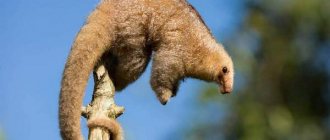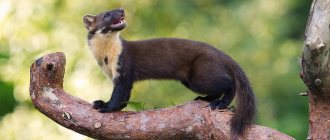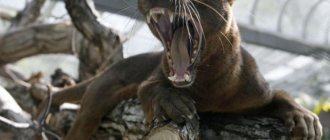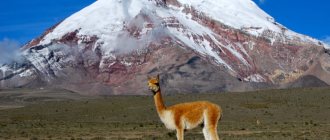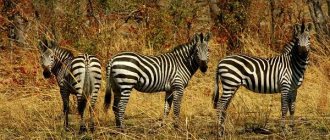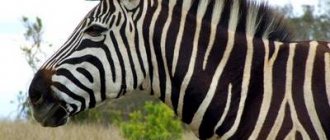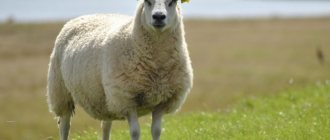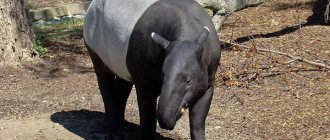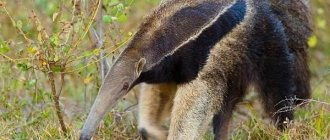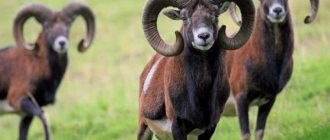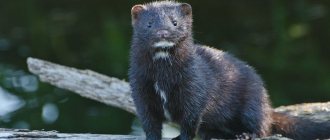- Wild animals
- >>
- Mammals
Russian muskrat , also known as khokhulya (Desmana moschata) is a very old, relict species of mammal.
It is believed that these animals have lived on Earth for about 30 million years. Previously, the distribution area extended over almost the entire European part of Eurasia - right up to the British Isles. Now the range has shrunk and is fragmented. The muskrat owes its name to its characteristic and very unpleasant smell of musk. The etymology of the name goes back to the old Russian word “hukhat”, i.e. "stink".
Origin of the species and description
Due to the antiquity of the species, accurately determining its origin is a very difficult task. The ancestors of the muskrat were small insectivorous animals, which, in the process of specialization, acquired an appearance and habits close to modern animals. Over 30 million years, evolution has not been able to change the muskrat much, so today we see it the same as mammoths and almost all the ancestors of modern humans could see it. Close relatives of the Russian desman are modern moles, with which desmans have many similar features in anatomy and biology.
The muskrat prefers to settle along quiet bodies of water in burrows that it digs itself. The dwellings are highly branched and go to the very edge of the water. The muskrat spends most of its time in burrows, hiding from its enemies, incl. from a person. The animal can swim well and has an excellent sense of smell and touch. The small body is covered with thick hair, which the animal processes with secretions of the musk gland. Thanks to this, the wool becomes water-repellent, but at the same time gives the muskrat a strong unpleasant odor.
The khokhulya feeds on small crustaceans, mollusks, insects and aquatic plants. The animal does not make reserves for the winter and does not hibernate, leading an active lifestyle all year round. Because of this feature, the muskrat cannot expand its range to the north - it is difficult for the animal to endure cold winters.
Taxonomy
The Russian desman or Ukrainian desman (lat. Desmana moschata) occupies the following position in taxonomy:
Khokhulya on the hands of a man
- Kingdom Animalia - Animals
- Phylum Chordata
- subphylum Vertebrata - Vertebrates
- Class Mammalia-Mammals
- Order Insectivora - Insectivores
- Family Moles or Shrews
- Subfamily Desmaninae (sometimes classified as a family; the second species is the Pyrenean muskrat (Galemys pyrenaicus)
- Rod Muskrat -Desmana
- V.russkaya species - D. moschata
Muskrat - water mole
Appearance and features
Russian muskrat photo
The muskrat is small in size - only about 20 cm, plus a tail of approximately the same length. Total - about 40 centimeters. Body weight is approximately 400 - 500 grams. The head is small, on a short neck, with an elongated muzzle ending in a movable stigma with a nose and tufts of very sensitive whiskers - whiskers. Small eyes are surrounded by lighter, hairless areas of skin; vision is very weak. In everyday life, the muskrat relies more on other senses than on vision. And during the hunt, it generally closes its eyes and uses exclusively its whiskers.
The muskrat's tail is long, very mobile, flattened laterally. It is covered with small scales and has no hair at all. It is used by the animal when swimming as an additional propulsion device and rudder. The muskrat's limbs are short. There are membranes between the toes, which also makes swimming easier. The front legs are short, clubfooted, mobile, with large claws. The muskrat uses them to dig multi-meter networks of holes. On land, these mammals move slowly and clumsily, but swim much faster and more agilely in water.
The body of the animal is covered with thick fur soaked in musk. Musk performs a water-repellent function. Thanks to this, the fur does not get wet and dries very quickly. The color of the coat on the back is gray-brown, the belly is gray-silver. This coloring performs a camouflage function both in water and on land. In fact, it was precisely because of the musk and skin with fur that the population of the muskrat was reduced to catastrophic proportions. For many centuries, the animal had commercial value, first for musk, and then as a fur breed. The final ban on fishing was introduced only in the middle of the 20th century.
Interesting facts about the animal
Fur-bearing animals have long been valued, and there was a large trade for them. Until the 17th century, it was caught for its musky aroma. Clever housewives laid out the laundry with dry muskrat tails. A little later, the odorous substance began to be used for perfume products to enhance and preserve the aroma of perfumes. Then people noticed the beautiful, warm fur and realized the practicality and other advantages of the shiny skin.
This turned out to be a fatal factor for the animal; the value of the fur contributed to the active extermination of the mammal. They hunted mercilessly, wanting to enrich themselves, so much so that they almost completely exterminated the muskrat. Realizing the depth of the tragedy, people were forced to put a ban on the production of this endangered species. By the end of the 70s of the 20th century, it was possible to increase the number to 70 thousand individuals. Then the decline began again.
The Russian muskrat is the oldest representative of the fauna of planet Earth. This beast went through all the evolutionary stages of development along with humanity, and survived many global catastrophes. What’s a shame is that it is gradually dying out due to the harmful activities of people.
To prevent complete extinction of the species, it is necessary to protect and promote the restoration of its numbers. This requires the creation of special programs at the legislative level to improve and restore the natural habitat of this interesting furry animal.
Still have questions or have something to add? Then write to us about it in the comments, this will make the material more useful, complete and accurate.
Where does the Russian muskrat live?
At the moment, the Russian desman is distributed in small areas of the Volga, Don, Dnieper and Ural river basins. Now the range continues to shrink. This is due to both climate change and human activity.
The muskrat leads a very secretive lifestyle. It lives near quiet bodies of water, in the banks of which it digs branched burrows. In some cases, the total length of all tunnels and chambers of the burrow can exceed 10 meters! In its dungeons, the animal rests after the hunt, feeds, and raises its offspring. Khokhulya prefers to settle in quiet places with lush coastal vegetation. On such banks it is easier for the animal to hide from danger, and it is also easier to survive periods of high water. If a reservoir is characterized by frequent strong changes in water level, then the muskrat makes multi-tiered burrows with several entrances.
The animal tries to enter the hole at the very edge of the water. From the entrance to the dwelling, a groove stretches along the bottom, often with several branches. This is a kind of underwater path that allows the muskrat not to get lost and quickly find the right path. Often grooves connect the main burrow with additional ones - feeding ones, in which the animal can safely eat, rest, or simply breathe in fresh air. The distance between burrows does not exceed 25-30 meters, because This is approximately how far a muskrat can swim underwater in one breath. As the water level drops, the muskrat deepens the grooves near the entrance to the hole and continues to use them.
Floods are a very difficult time for muskrats. She has to leave her hole and wait out the rising water in some temporary shelters. At this time, the animals are especially vulnerable and often become prey to predators. If it fails to gain a foothold, the animal is carried away by the current. Not all individuals survive. But this is also how the muskrat spreads.
What does the Russian muskrat eat?
Possessing great mobility and a high metabolism, the Russian desman needs a large amount of high-calorie food. This activity is maintained almost throughout the year. The basis of the diet of the Russian muskrat is animal food, although the animal does not disdain aquatic vegetation.
Most often, muskrats appear on the menu:
- aquatic insects;
- insect larvae;
- small crustaceans;
- shellfish;
- leeches and other worms.
In addition, the animal happily feasts on small fish and frogs if it manages to catch them. Periodically supplements its diet with stalks of cattails, reeds, and egg capsules.
The khokhulya hunts exclusively in water, and eats its prey on land. During the hunt, the animal orients itself with the help of whiskers. Having discovered prey, it grabs it with its teeth and carries it to a hole or secluded place on the shore, where it feasts on it. In addition to soft insect larvae, the muskrat also copes well with shellfish thanks to its strong and sharp front teeth. Since the muskrat’s “dining room” is located in the same place, it is not difficult to find the habitat of this secretive animal from the remains of food.
An important role in the hunting process of the Russian desman is played by the grooves on the bottom of the reservoir. Constantly moving along them, the animal ensures periodic circulation of water and enriches it with air. Aquatic insects and their larvae more actively swim into oxygen-rich water, which the khokhulya hunts.
Diet, nutrition Khokhuli
In the warm season from May to October, the main diet of the muskrat consists of small insects, larvae and crustaceans, and less often leeches and marsh plants. Because these animals do not hibernate in winter, they do not accumulate fat reserves. In winter, things are much more difficult for Khokhuli with food.
As food, they can catch a hibernating frog, small fish, which at this time also become easy prey, as well as river mollusks. These animals have an excellent appetite, sometimes the weight of the food eaten is equal to the weight of the animal itself. This is explained by the fact that they are very mobile and have a fast metabolism.
Return to content
Features of character and lifestyle
The Russian muskrat is a semi-aquatic mammal that breathes atmospheric air. But the way of life left its mark and this ancient animal developed several adaptations for such a habitat. The main ones are the ability to swim underwater and hold your breath for a long time. If the animal senses danger above the water and needs to breathe, then the muskrat carefully sticks its snout with nostrils above the surface of the water and breathes. This continues until the danger disappears.
Despite the fact that the Ukrainian has good hearing, it does not react to all sound stimuli. It has been repeatedly noted that human speech or the noise of cattle on the shore sometimes does not have the same effect as a slight splash or rustle of grass on the shore. Nevertheless, the muskrat tries to remain secretive and hides at the slightest danger.
The Russian desman usually lives in family groups. One family owns one developed network of burrows, in which all individuals coexist harmoniously. But these animals cannot be called peaceful and docile! Often conflicts arise between representatives of different families, which can even lead to the death of one of the individuals. But this rarely happens. Usually the matter ends in a peaceful showdown or intimidation. Attacks are more often observed by adult animals on young animals from a neighboring clan.
The Russian desman tries to maintain friendly relations with aquatic and semi-aquatic animals of other species. So, there is even some semblance of symbiosis with the beaver. Khokhulya often uses beaver burrows for his own purposes, and as payment eats mollusks that can carry beaver pathogens. This way both win. The Russian desman has no food competition with beavers.
The muskrat develops a multi-faceted relationship with another aquatic mammal, the muskrat. The animals do not enter into direct confrontation and sometimes even occupy the same hole, but cases are not uncommon when a larger muskrat displaces a weaker animal. This is leading to a decline in muskrat numbers in some areas.
Area, distribution
The Russian muskrat is widespread in central Russia . Their main habitats are located along rivers with weak currents or near standing bodies of water. It is very good if the banks of such reservoirs are covered with dense vegetation, and the soil consists mainly of sandstones and loams. These are the most suitable conditions for the Russian muskrat.
This is interesting! They often coexist with beavers and peacefully share habitats with them, since they are not competitive species, and beavers are not interested in them as a food resource.
Previously, these animals were often found in the forests of Eastern and part of Western Europe; currently they are on the verge of extinction and are under the protection of international organizations.
Return to content
Social structure and reproduction
As noted above, the Russian muskrat lives in family groups consisting of parents and the last generation of young animals. Sometimes, when the density of animals is high, unrelated individuals or older cubs join the family. Each muskrat family lives in its own burrow and controls the space around it. When meeting with representatives of neighboring clans, conflicts may arise.
Russian muskrats breed up to twice a year. Usually in spring (during high water) and late autumn. Pregnancy in a female lasts about 1.5 months. All this time, she prepares one of the chambers in the hole, in which she then gives birth and feeds her offspring. Khokhuli has up to five cubs in one litter. They are born naked, defenseless and helpless, weighing only 3-5 grams. In the first two weeks, the mother relentlessly cares for the offspring, feeding with milk, warming and licking. Later, the mother begins to leave the cell to rest for short periods of time. The male protects the family and cares for the female during this period.
If the female is disturbed during the period of feeding her offspring, then most often she transfers the offspring to another chamber or even to another burrow. The mother moves the cubs through the water, placing them on her stomach. The worried father is usually the first to leave the hole.
For the first month, the mother feeds the cubs exclusively with milk. When babies are one month old, teeth appear and they begin to try adult foods. From about one and a half months, young muskrats begin to leave the hole and try to get food on their own. By the age of six months they are already completely independent, and by 11 months they become sexually mature and leave the parental hole.
Natural enemies of the Russian muskrat
Although the muskrat leads a very secretive and cautious lifestyle, it has plenty of enemies in the wild! Having a very small size, this animal often becomes prey for predators.
Main enemies on land:
- foxes;
- otters;
- ferrets;
- wild cats;
- some birds of prey.
Usually a furry animal becomes a victim on land, because... the paws are poorly adapted to moving on land. The most dangerous time in this regard is the spring flood. And this is precisely the time of mating season. Animals engaged in pair selection lose their vigilance, and a flooded reservoir deprives them of their natural shelter - a burrow. Therefore, muskrats become easy prey for predators. Also, significant harm is caused by wild boars, which, although they do not hunt adult animals, often tear up their burrows.
In water, the khokhulya is more agile and less susceptible to attack, but even here it is not completely safe. A small animal can become prey for a large pike or catfish. Another serious enemy of the muskrat is man and his activities. For centuries he has been exterminating animals for fur and musk. But if commercial hunting for the Khokhul is now prohibited and it is protected, then the destruction of its natural habitat continues to reduce the number of these ancient animals.
Reasons for disappearance
The muskrat is listed in the Red Book. The number of these animals by 1973 was about 70 thousand throughout the USSR. Basically, the reduction in the number of these animals occurred due to the fact that their fur is very, very valuable.
In the early and mid-19th century, the hunt for these animals was in full swing, and approximately 100 thousand animals were destroyed every year. Due to such widespread persecution of these animals, as well as violation of their habitat (draining of water bodies), their numbers have dropped sharply.
Population and species status
Once upon a time, several centuries ago, the Russian muskrat lived almost throughout Europe and its numbers were at a safe level. But over the past 100-150 years, the range of this relict mammal has significantly decreased and become fragmented. Nowadays, the Ukrainian can be occasionally found in some areas of the Volga, Don, Ural and Dnieper basins. Rare sightings of muskrats have also been recorded in the Chelyabinsk and Tomsk regions.
Due to its secretive lifestyle, counting the number of the animal causes a number of difficulties, so at the moment their exact number is unknown. But a number of researchers believe that the muskrat population today, according to various sources, numbers about 30-40 thousand individuals. This is a negligible amount compared to the previous population, when tens of thousands of skins of this animal were brought to fairs every year, but it leaves hope for the survival of the species.
Habitats
Where does the muskrat live? This relict species is found, in addition to some places in Russia, also in certain places in Kazakhstan, Ukraine, Lithuania and Belarus.
A relict species in Russia has settled in the following places:
- In the Dnieper basin, these animals occupied such rivers as Iput, Vyazma, and Oster.
- In the Don basin they can be found in rivers such as Voronezh, Bityug, Khoper.
- In the upper reaches of the Volga, these animals are found in places such as Kotorosl and Uzha. This animal was also seen in the lower reaches of the Klyazma, Moksha and Tsna.
- In the Chelyabinsk region, the places where the muskrat lives are: the bottom of the Uy River in the Kurgan region, as well as in the Tobola floodplain.
